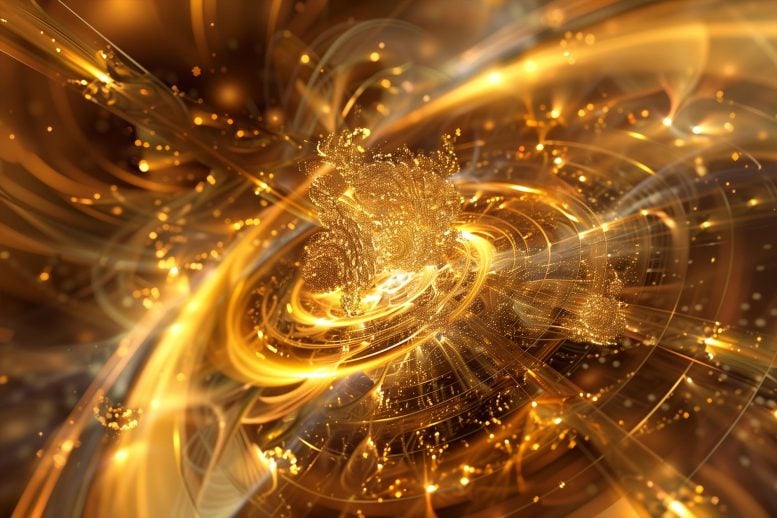
Studies on quark-gluon plasma from heavy nucleus collisions indicate viscosity increases with net-baryon density, enhancing our understanding of nuclear matter’s phases through advanced simulations. Credit: SciTechDaily.com
Advanced simulations of heavy atomic nucleus collisions have shown that the viscosity of the quark-gluon plasma increases with net-baryon density.
This research, significant for understanding the phase transitions of nuclear matter, leverages data from various energy collisions to refine theoretical models.
A fluidlike soup of visible matter’s fundamental building blocks, quarks, and gluons. is created when heavy atomic nuclei collide together. This soup has very low viscosity — a measure of its “stickiness,” or resistance to flow. Theorists have performed the first systematic study of whether and how this viscosity changes over a wide range of collision energies. The work takes into account changes that take place as the colliding nuclei pass through each other. The calculations predict that the fluid’s viscosity increases with net-baryon density — the relative abundance of baryons (particles made of three quarks, like the neutrons and protons that make up the colliding nuclei) over antibaryons (which are produced in the collision).
Viscosity Insights From Collision Data
This analysis determined the best parameters for fitting new simulations to experimental data from collisions of gold nuclei at different energies. It predicted increased viscosity with increasing net-baryon density. This agrees with some but not all theoretical predictions. In the future, scientists will use this same theoretical framework to incorporate additional data from a range of collision energies. These expanded simulations will not only provide information about viscosities. They will also offer data on the entire phase diagram of nuclear matter, which maps out how nuclear matter varies from a solid, liquid, gas, or plasma as a function of temperature and baryon density.

Physicists modeled gold-gold collisions at different energies to probe fluid properties over a range of temperatures & baryon densities. The dashed line represents the region where ordinary nuclear matter is expected to transition to free quarks & gluons. Credit: Chun Shen, Wayne State University
Advanced Simulation Techniques
This work combines state-of-the-art viscous fluid dynamic simulations in all three spatial dimensions with newly developed dynamic models of the collisions’ initial stage to describe heavy ion collisions at the Relativistic Heavy Ion Collider
(RHIC), a Department of Energy user facility, over a wide range of collision energies. Incorporating the evolution of the initial state allows for the continuous generation of fluid nuclear matter as the colliding nuclei pass through each other. This is particularly important at lower beam energies where the assumption of an instantaneous collision is not valid.
Event-by-Event Analysis in Nuclear Collisions
In this research, a team of theorists from Brookhaven National Laboratory, Lawrence Berkeley National Laboratory, the University of California Berkeley, and Wayne State University used this versatile model to perform event-by-event calculations that consider fluctuations in the initial geometry of the colliding nuclei and the resulting shape of the produced fireball. The researchers varied and constrained the parameters of the model, which include the viscosities of the produced matter as well as properties of the initial state, to perform a statistical analysis with input from experimental data collected during RHIC’s Beam Energy Scan (BES). This data-driven analysis of how viscosities depend on net-baryon density was based on 5 million numerically simulated collision events. Researchers can now compare this analysis to pure theoretical calculations. The same framework can be applied to measurements from BES Phase II at RHIC and at the future Facility for Antiproton and Ion Research (FAIR) in Europe.
Reference: “Viscosities of the Baryon-Rich Quark-Gluon Plasma from Beam Energy Scan Data” by Chun Shen, Björn Schenke and Wenbin Zhao, 16 February 2024, Physical Review Letters.
DOI: 10.1103/PhysRevLett.132.072301
This research was funded by the Department of Energy Office of Science, Office of Nuclear Physics and the National Science Foundation. The research used computational resources of the Open Science Grid, supported by the National Science Foundation.

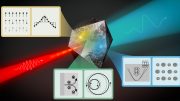

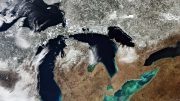
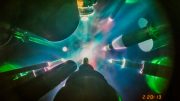


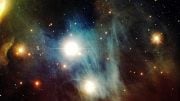

The researchers varied and constrained the parameters of the model, which include the viscosities of the produced matter as well as properties of the initial state, to perform a statistical analysis with input from experimental data collected during RHIC’s Beam Energy Scan (BES). This data-driven analysis of how viscosities depend on net-baryon density was based on 5 million numerically simulated collision events. Researchers can now compare this analysis to pure theoretical calculations.
Very good!
Keep trying.
Scientific research guided by correct theories can help humanity avoid detours, failures, and pomposity. Is this the fairy tale world of contemporary physics? Please witness the exemplary collaboration between theoretical physicists and experimentalists (https://zhuanlan.zhihu.com/p/701032654).